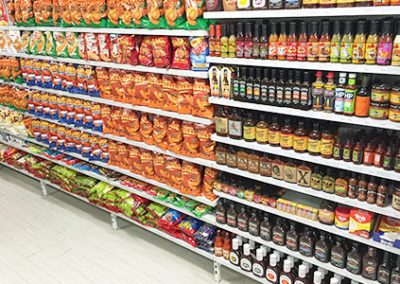Getting My I Luv Candi To Work
Getting My I Luv Candi To Work
Blog Article
The Ultimate Guide To I Luv Candi
Table of ContentsSome Of I Luv Candi6 Simple Techniques For I Luv CandiThings about I Luv CandiThe Of I Luv CandiWhat Does I Luv Candi Mean?
You can additionally approximate your own profits by using different assumptions with our financial strategy for a sweet-shop. Ordinary regular monthly revenue: $2,000 This kind of sweet-shop is often a tiny, family-run organization, maybe understood to locals yet not bring in big numbers of tourists or passersby. The shop could use a choice of common sweets and a few homemade deals with.
The store doesn't typically lug unusual or expensive products, concentrating instead on budget friendly treats in order to maintain routine sales. Presuming an average investing of $5 per customer and around 400 consumers per month, the monthly earnings for this sweet-shop would be about. Typical month-to-month profits: $20,000 This sweet shop advantages from its strategic place in a busy city area, drawing in a lot of clients looking for wonderful extravagances as they shop.

In enhancement to its diverse sweet selection, this store could additionally offer relevant products like present baskets, candy bouquets, and uniqueness things, giving multiple income streams. The shop's place requires a greater allocate rental fee and staffing yet results in higher sales volume. With an estimated typical spending of $10 per client and about 2,000 customers per month, this shop can generate.
5 Simple Techniques For I Luv Candi
Located in a significant city and vacationer location, it's a big establishment, typically spread over several floorings and potentially component of a national or international chain. The store uses an immense variety of candies, consisting of unique and limited-edition products, and goods like top quality garments and devices. It's not just a store; it's a destination.
The operational costs for this kind of shop are significant due to the place, size, team, and features provided. Presuming an ordinary acquisition of $20 per client and around 2,500 clients per month, this front runner store might achieve.
Category Examples of Expenditures Ordinary Month-to-month Expense (Variety in $) Tips to Decrease Expenditures Rent and Utilities Store lease, electrical energy, water, gas $1,500 - $3,500 Think about a smaller place, work out lease, and make use of energy-efficient lights and appliances. Stock Candy, snacks, packaging products $2,000 - $5,000 Optimize supply monitoring to reduce waste and track popular things to prevent overstocking.
Rumored Buzz on I Luv Candi
Advertising and Advertising and marketing Printed materials, on-line advertisements, promos $500 - $1,500 Concentrate on economical digital advertising and marketing and utilize social networks systems free of charge promotion. Insurance policy Company responsibility insurance policy $100 - $300 Shop around for competitive insurance policy rates and take into consideration packing policies. Equipment and Maintenance Cash signs up, show racks, repairs $200 - $600 Buy pre-owned tools when possible and do regular maintenance to prolong devices life-span.
:max_bytes(150000):strip_icc()/193520kit20kat-2000-769a04c7c94a4d03bef6d728f08d7dff.png)
This suggests that the sweet store has reached a point where it covers all its taken care of costs and starts generating income, we call it the breakeven factor. Consider an instance of a sweet-shop where the regular monthly set expenses typically amount to approximately $10,000. A rough price quote for the breakeven point of a sweet-shop, would then be around (given that it's the overall set price to cover), or marketing between with a rate series of $2 to $3.33 per unit.
About I Luv Candi
A big, well-located sweet store would certainly have a greater breakeven factor than a small store that does not require much income to cover their costs. Interested about the productivity of your sweet store?
Another danger is competitors from various other candy stores or larger merchants who may supply a wider variety of products at lower costs (https://bit.ly/3xabGcF). Seasonal variations sought after, like a decline in sales after holidays, can likewise influence productivity. Additionally, altering customer choices for healthier snacks or nutritional constraints can minimize the allure of conventional sweets
Last but not least, financial downturns that decrease customer costs can influence candy store sales and success, making it crucial for sweet-shop click for more to handle their expenditures and adjust to changing market conditions to stay rewarding. These risks are usually included in the SWOT evaluation for a sweet-shop. Gross margins and net margins are essential indicators utilized to evaluate the earnings of a sweet store service.
The I Luv Candi Statements
Basically, it's the revenue remaining after subtracting expenses straight pertaining to the candy stock, such as purchase prices from providers, manufacturing costs (if the sweets are homemade), and staff wages for those associated with manufacturing or sales. https://iluvcandiau.carrd.co/. Web margin, on the other hand, factors in all the expenditures the sweet store sustains, consisting of indirect costs like management costs, marketing, rental fee, and taxes
Sweet stores normally have an ordinary gross margin.For instance, if your candy shop gains $15,000 per month, your gross profit would be about 60% x $15,000 = $9,000. Think about a sweet shop that sold 1,000 candy bars, with each bar priced at $2, making the complete income $2,000.
Report this page